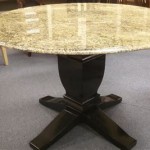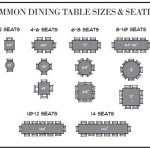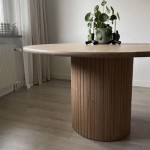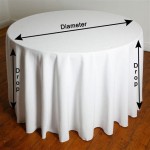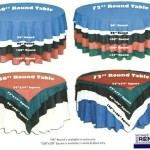How Many Chairs for a 60-Inch Round Table?
Determining the optimal number of chairs to place around a 60-inch round table is a crucial aspect of event planning, dining room design, and overall space utilization. The answer isn't a fixed number, as several factors influence the appropriate configuration. Considerations ranging from comfort to accessibility play a significant role in achieving a balanced and functional seating arrangement. This article delves into the various elements that should be evaluated when deciding how many chairs should accompany a 60-inch round table.
A 60-inch round table, measuring five feet in diameter, provides a substantial surface area, lending itself well to various applications. It is common in dining rooms, conference spaces, and event venues. Its circular shape fosters conversation and a sense of inclusivity, making it a popular choice. However, effectively maximizing its seating capacity requires a careful balance between allowing adequate personal space and accommodating a reasonable number of guests.
In this article, key considerations such as chair size, the purpose of the table, and the desired level of comfort will be explored. This multifaceted guide aims to equip readers with the knowledge necessary to make informed decisions about seating arrangements, ensuring a pleasant and functional experience for all users.
Key Point 1: The Standard Recommendation and Factors Affecting It
While a 60-inch round table is often cited as comfortably seating six to eight people, this is merely a general guideline. The actual number of chairs that can be accommodated depends on a range of interconnected factors. Deviation from this standard may be needed based on specific circumstances.
The primary factor influencing seating capacity is the size of the chairs themselves. Bulkier chairs with wide arms or expansive bases will naturally require more space, reducing the number that can be comfortably positioned around the table. Conversely, smaller, armless chairs, such as bistro chairs, will allow for a greater number of seats. It’s important to measure the width of the chairs at their widest point to accurately assess how much space each chair will occupy along the circumference of the table. Consider the stylistic choices of the chairs and their practical impact on the overall number of seats that can be arranged surrounding the table.
The intended use of the table is another critical consideration. A formal dining setting typically demands more personal space than a casual gathering. Formal dinners often involve multiple courses and require more room for maneuvering plates and cutlery. In contrast, a conference table might be used for shorter periods, allowing for a slightly more compact seating arrangement. If the table will be used for activities that require ample elbow room, such as crafting or games, reducing the number of chairs may be necessary to ensure participants have sufficient personal space.
Furthermore, comfort levels play a significant role. While it may be possible to squeeze in more chairs, doing so can lead to a cramped and uncomfortable experience. Guests may feel confined and have difficulty moving around or engaging in conversation. Factors such as legroom and ease of entry and exit should be taken into account. A comfortable seating arrangement will enhance the overall experience and encourage more positive interactions.
Ultimately, the determination of chair quantity should be based on a thorough assessment of these factors. Simply adhering to a standard recommendation without considering the specific context can lead to suboptimal seating arrangements. Prioritizing comfort and practicality will result in a more enjoyable and functional space for all occupants.
Key Point 2: Measuring and Calculating for Optimal Spacing
Accurate measurements and simple calculations are essential for maximizing seating capacity while maintaining comfort around a 60 inch table. This involves evaluating the chair's dimensions and considering the necessary space for each guest to move comfortably.
Begin by measuring the width of the chairs at their widest point, typically across the seat or arms. This measurement represents the space each chair will occupy along the table's perimeter. To ensure comfortable spacing, it is generally recommended to allocate at least 24 to 30 inches per person. This provides sufficient room for each guest to sit comfortably and move their arms without bumping into their neighbors.
To calculate the ideal number of chairs, divide the circumference of the table by the desired spacing per person. The circumference of a circle is calculated using the formula C = πd, where 'C' is the circumference, 'π' (pi) is approximately 3.14159, and 'd' is the diameter. In the case of a 60-inch table, the circumference is approximately 188.5 inches (3.14159 x 60). If you aim for 24 inches of space per person, you would divide 188.5 by 24, resulting in approximately 7.85. This suggests that slightly less than eight chairs can be comfortably accommodated. If you choose to allocate 30 inches per person, divide 188.5 by 30, yielding approximately 6.28, indicating that six chairs would be a more reasonable arrangement.
It's important to note that this calculation provides an estimate. Practical considerations, such as the presence of table legs or decorative elements that might obstruct chair placement, should be factored into the final decision. Moreover, the shape of the chair backs can influence the overall spacing required. Chairs with angled backs might require slightly more room to ensure that guests can easily pull their chairs away from the table.
Visualizing the seating arrangement before making a final decision is helpful. Mock-up the arrangement using the actual chairs to be used or by outlining the chair dimensions on the floor around a similar-sized circle. This allows for a practical assessment of the spacing and helps identify any potential issues, such as inadequate legroom or obstructions. Adjust the number of chairs as needed to achieve the desired balance between seating capacity and comfort.
By applying these principles of measurement and calculation in conjunction with a practical assessment, it is possible to optimize the chair quantity for a 60-inch table. This will result in a seating arrangement that is both functional and comfortable, enhancing the overall experience for all users.
Key Point 3: Alternative Seating Arrangements and Space Considerations
While individual chairs are the most common seating option for round tables, exploring alternative arrangements, such as banquettes or curved benches, can provide a unique aesthetic and potentially maximize seating capacity. Additionally, understanding the broader space considerations surrounding the table is essential for ensuring a functional and comfortable environment.
Banquettes, particularly those custom-built to fit the curve of the table, can offer a space-saving solution. A banquette can seat more people along a continuous surface than individual chairs, particularly in situations where space is limited. However, banquettes also have drawbacks. They typically offer less flexibility in terms of individual seating arrangements, and guests may find it more challenging to enter and exit the seating area. The design and construction of the banquette should prioritize comfort and ease of access to mitigate these potential issues.
Curved benches present another alternative. These often offer a more casual and flexible seating solution than banquettes. They can be easily moved and rearranged, allowing for greater adaptability. However, like banquettes, curved benches may not appeal to all users due to the communal seating arrangement. Providing comfortable cushions and backrests is crucial to ensure that guests remain comfortable throughout their time seated.
Beyond the immediate seating arrangement, the surrounding space is equally important. Adequate circulation space is necessary to allow guests to move freely around the table without bumping into chairs. A minimum of 36 inches of clearance between the edge of the table and any walls or other obstacles is generally recommended. This allows guests to comfortably pull out their chairs and navigate the space.
The placement of the table within the room should also be carefully considered. Avoid positioning the table in a high-traffic area, as this can disrupt conversations and create an uncomfortable environment. Ideally, the table should be located in a central location that is easily accessible from all areas of the room. This will encourage interaction and create a more cohesive atmosphere.
Lighting, both natural and artificial, can significantly impact the ambiance of the seating area. Ensure that the table is well-lit to facilitate conversation and create a welcoming environment. Avoid placing the table in a location where it is subject to glare or harsh shadows. Soft, diffused lighting is generally preferred, as it creates a more comfortable and inviting atmosphere.
By considering these alternative seating arrangements and space considerations, you can create a more functional, comfortable, and aesthetically pleasing environment around a 60-inch round table. Exploring all available options and prioritizing user comfort will ultimately lead to a more positive and enjoyable experience for all.

Professional Table Seating Guide The Chiavari Chair Company Is Now Chivari
6 60 Round Tables 36 Chairs

The Right Number Of Chairs For Any Table Canadel S Blog

Lifetime 60 Inch Round Table And 8 Chairs Combo

Linen Table Sizing Chair Als In Detroit Surrounding Areas

60 Round Table Facade Theme Party

Table Size Seating Capacity Round Rectangular More Dining Room Sizes Large

60 In Round Table Mtb Event Als

Round 60 Inch Party Table Al Seats Up To 10 S

Professional Table Seating Guide The Chiavari Chair Company Is Now Chivari
Related Posts


